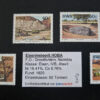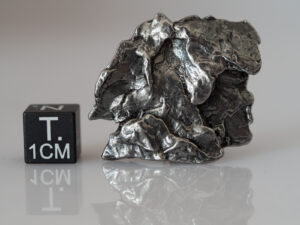Description
4.6g part slice of the Hoba meteorite. Sold with labels/certificate. Very rare !
I’ll add as gifts a shale of the Hoba meteorite and Hoba stamp.
Provenance : … > (1998) Alexander Seidel > (2021) Jürgen Nauber > me
The Hoba[1] (/ˈhoʊbə/ HOH-bə) meteorite is named after the farm Hoba West, where it lies, not far from Grootfontein, in the Otjozondjupa Region of Namibia. It has been uncovered, but because of its large mass, has never been moved from where it fell. The main mass is estimated at more than 60 tonnes. It is the largest known intact meteorite (as a single piece) and about twice as massive as the largest fragment of either the Cape York meteorite’s 31-tonne Ahnighito kept in the American Museum of Natural History or the Campo del Cielo’s 31-tonne Gancedo in Argentina. It is also the most massive naturally occurring piece of iron (actually ferronickel) known on Earth’s surface. The name Hoba comes from a Khoekhoegowab word meaning ‘gift’. Following its donation to the government in 1987, a visitor centre was constructed with a circular stone access and seating area.
The Hoba meteorite is thought to have impacted Earth less than 80,000 years ago. It is inferred that the Earth’s atmosphere slowed the object in such a way that it impacted the surface at terminal velocity, thereby remaining intact and causing little excavation (expulsion of earth). Assuming a drag coefficient of about 1.3, the meteor appears to have slowed to about 2.75 km/s (6140 mph) from an entry speed to the atmosphere typically in excess of 10 km/s (22,370 mph). The meteorite is unusual in that it is flat on both major surfaces.
The Hoba meteorite left no preserved crater and its discovery was a chance event. In 1920, the owner of the land, Jacobus Hermanus Brits, encountered the object while ploughing one of his fields with an ox. While working the field, he heard a loud metallic scratching sound and the plough came to an abrupt halt. The obstruction was excavated, identified as a meteorite and described by Mr. Brits, whose report was published in 1920 and can be viewed at the Grootfontein Museum in Namibia.
Friedrich Wilhelm Kegel took the first published photograph of the Hoba meteorite.







